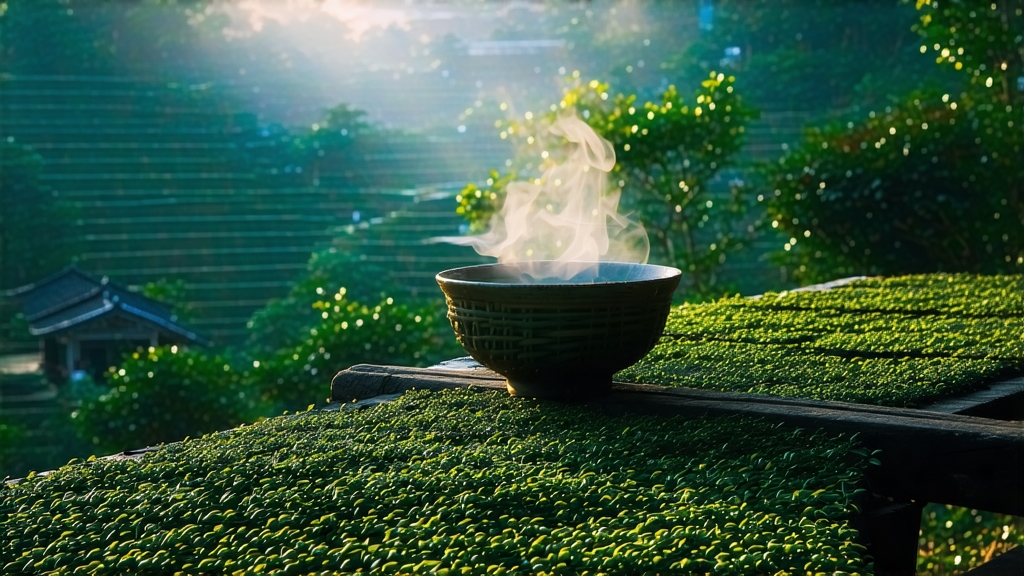
Tucked away in the humid folds of southern China’s Guangxi Zhuang Autonomous Region, Liu Bao tea has spent four centuries quietly perfecting the art of microbial alchemy. To the casual observer it is merely another dark brick stacked in the dim back room of a tea shop, yet to the initiated it is liquid history—an edible time-capsule whose flavor deepens with every monsoon it survives. While Pu-erh has become the global shorthand for fermented tea, Liu Bao remains the insider’s secret, a tea that Cantonese dock workers once sipped to cut the grease of river fish and that modern connoisseurs chase for its elusive “betel-nose” aroma. This article invites the international reader to journey into the mist-crowned valleys of Wuzhou, to understand why Liu Bao was once the currency of maritime trade and how, today, it is re-emerging as the benchmark of graceful aging in the post-fermented tea world.
Historical currents
The story begins during the late Ming dynasty, when the Qing-Xiang trade route connected the mountain hamlets of Cangwu county with the bustling Pearl River delta. Tea leaves too coarse for the imperial court were pressed into bamboo baskets, loaded onto mule caravans, and marched southward. Months of tropical heat and humidity inside those baskets triggered an accidental fermentation; upon arrival the tea had darkened, mellowed, and acquired a medicinal sweetness that Guangzhou apothecaries prized for “clearing dampness.” By the Qing era, Liu Bao had become a staple ballast in the cargo holds of Chinese junks sailing to Southeast Asia; laborers in Singapore and Kuala Lumpur brewed it in kettles thick with lard, believing the tea sterilized river water and soothed joints swollen from loading tin. British port records from 1886 list “Lieu-Pow” among the top three teas re-exported from Hong Kong, alongside Keemun and Lapsang Souchong. The 20th century brought wars, trade embargos, and a shift toward Pu-erh, pushing Liu Bao into near oblivion—until a small cohort of Hong Kong tea merchants, nostalgic for the taste of their childhood, began hoarding surviving baskets in the 1990s. Their cellars became living archives, and today a 1958 Liu Bao can command auction prices rivaling first-growth Bordeaux.
Micro-terroirs and leaf grades
Liu Bao is not a single garden but a constellation of micro-terroirs scattered across the limestone karsts of Wuzhou. The highest plots, at 600–800 m in the village of Liudong, yield slow-grown leaves rich in amino acids, producing a tea that ages into orchid and honey. Lower elevations around Dazhushan give bolder, more tannic leaf that favors the earthy, camphor profile beloved in Malaysia. Farmers recognize three traditional grades: first-pick “teji” (special grade) consisting of one bud with two leaves; “yiji” (grade 1) that allows slightly larger leaf; and “sanjie” (third cut) harvested after the main flush, whose robust fiber stands up to repeated wet-piling. Crucially, the leaf comes from a local sub-variety of Camellia sinensis var. sinensis known as “medium-leaf Wu,” whose serrated edges are gentler than Yunnan’s broad-leaf Da Ye, yielding a liquor that is less astringent at the start and more nuanced after decades.
Basket fermentation: where tea meets microbiome
Unlike the wo-dui (wet-piling) of Pu-erh, Liu Bao undergoes “basket fermentation,” a gentler process that predates the Yunnan technique by at least a century. Fresh leaf is first withered on bamboo racks for 12–16 hours, allowing moisture to drop to 65 %. A quick kill-green at 280 °C in a coal-heated wok deactivates enzymes within 3 minutes, preserving a faint grassy note that will later transmute into dried longan. While still warm, the leaf is rolled into tight curls, breaking cell walls for future microbial access. The innovation comes next: the leaf is stuffed—still damp—into cylindrical bamboo baskets lined with wild taro leaves. The baskets, each holding 35–40 kg, are stacked in an unheated curing room whose windows are opened only at night to invite mountain mist. Over 25–30 days the core